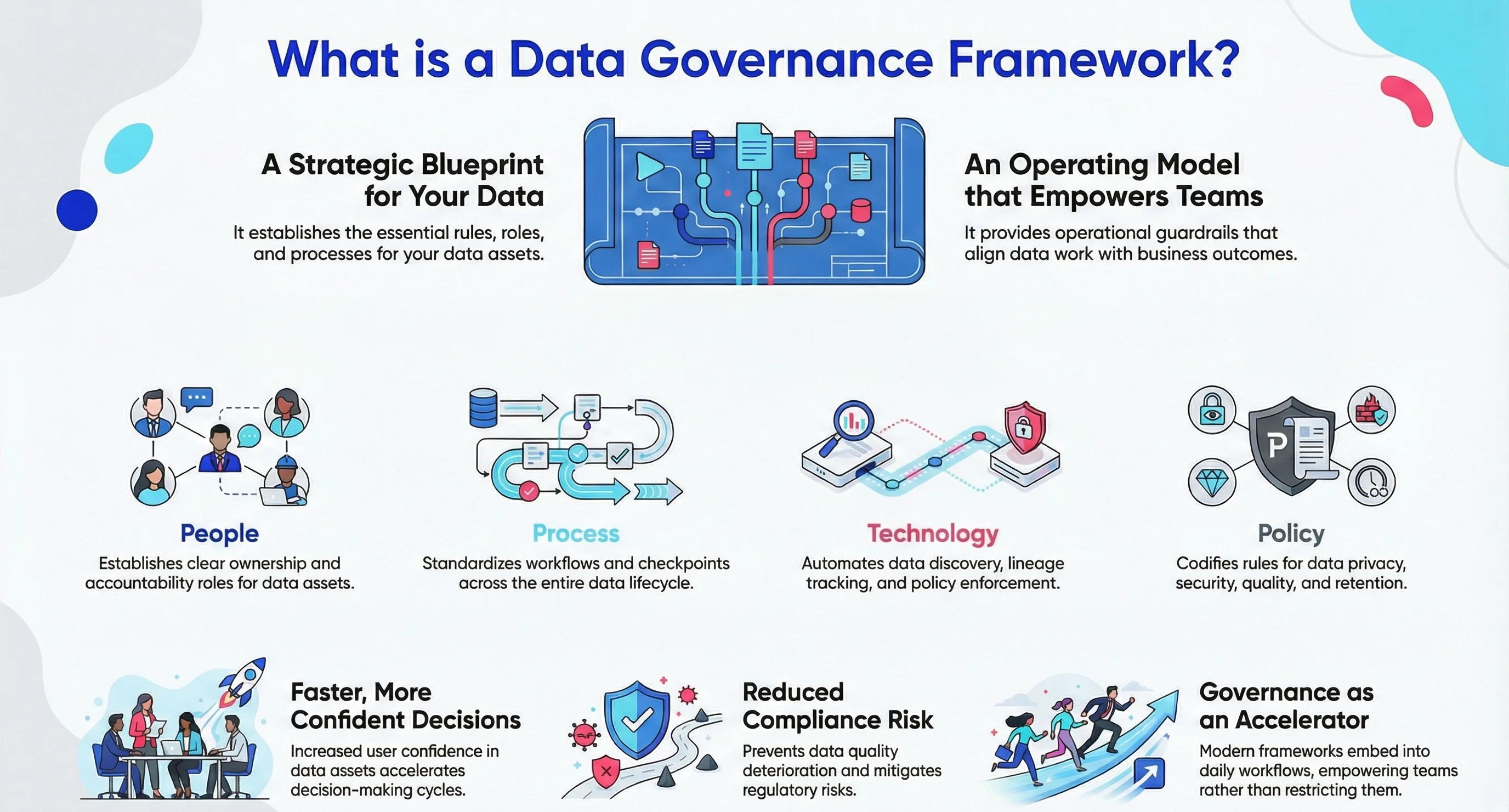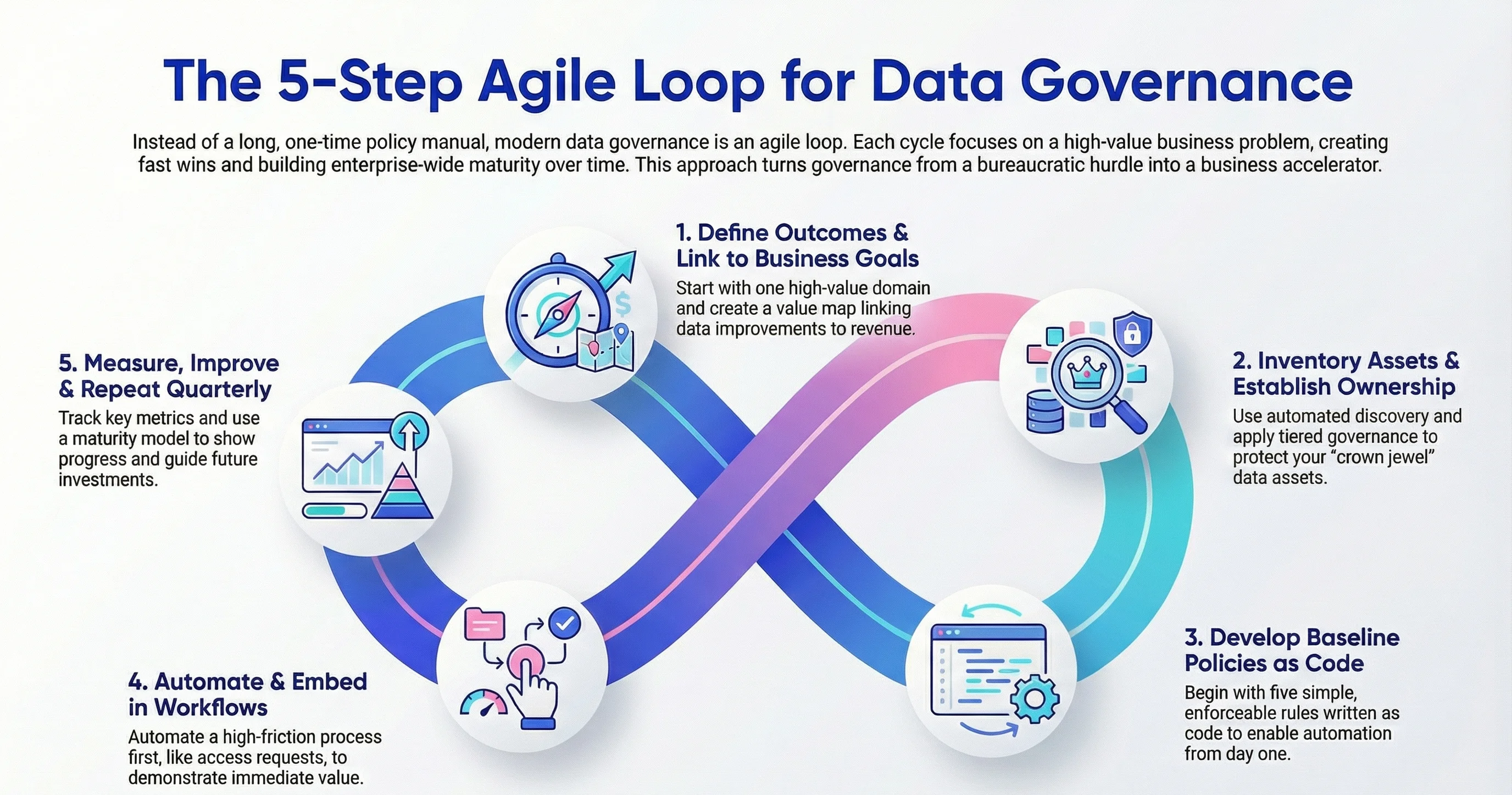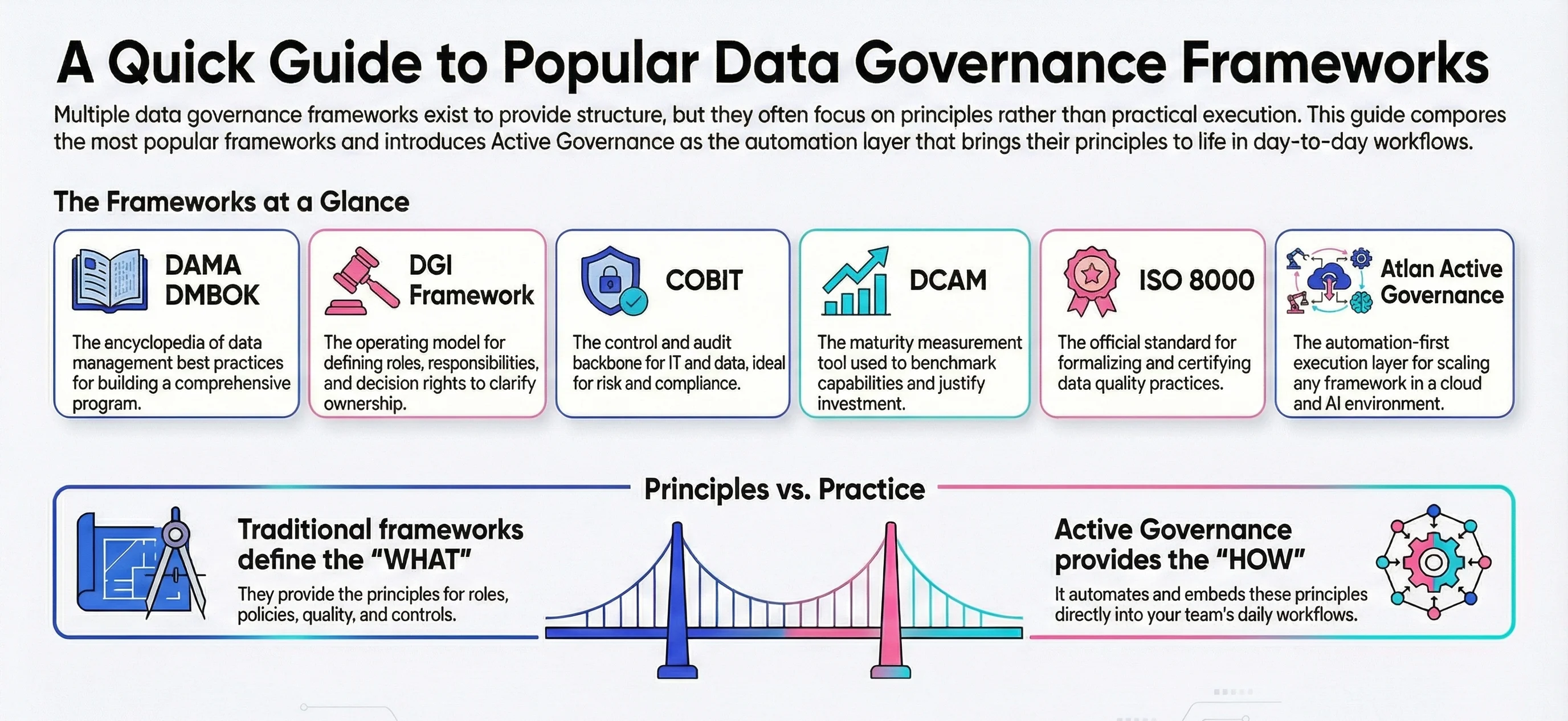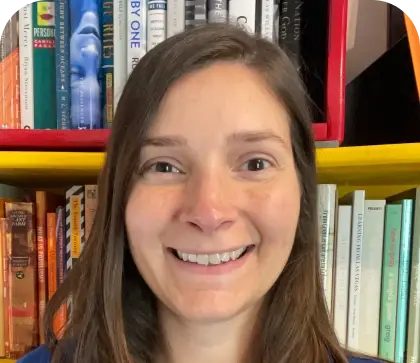Data Governance Framework 2026: Pillars, Objectives and Implementation guide
What is a data governance framework?
Permalink to “What is a data governance framework?”Summarize and analyze this article with 👉 🔮 Google AI Mode or 💬 ChatGPT or 🔍 Perplexity or 🤖 Claude or 🐦 Grok (X) .
Data governance framework is a structured operating model for how an organization manages, secures, and uses its data to maximize business value and ensure compliance. The three core ideas of a good data governance framework is:
- It is an operating model, not a document
- It creates operational guardrails that empower teams
- It aligns governance work with business outcomes
Modern frameworks embed governance into daily workflows rather than relying on standalone documentation or centralized bottlenecks. This shift turns governance into a business accelerator rather than a blocker.

What is a data governance framework - Image by Atlan.
What are the core components of a data governance framework?
Permalink to “What are the core components of a data governance framework?”Effective frameworks consist of four foundational components that integrate seamlessly to transform abstract principles into operational reality.
People: Ownership and accountability
Permalink to “People: Ownership and accountability”A strong people foundation makes data responsibility clear at every stage, eliminating gaps and orphaned assets.
Key roles:
- Data Governance Council: Cross functional leaders who set strategy, approve policies, and resolve issues needing executive alignment.
- Data Owners: Business leaders accountable for domain level accuracy, quality, and business value.
- Data Stewards: Day to day managers ensuring quality, policy enforcement, and operational compliance.
- Data Custodians: Technical teams that implement controls, manage storage, and maintain supporting infrastructure.
Modern teams use federated stewardship, where domains self govern and central teams set standards. This scales well by keeping decisions with experts closest to the data while maintaining guardrails.
Strong programs also rely on community governance groups and executive sponsors who champion data initiatives and keep the organization aligned and committed
Process: Standardized workflows
Permalink to “Process: Standardized workflows”Clear processes turn policy into everyday practice.
Core elements :
- Data lifecycle: Defined checkpoints from creation to quality checks, certification, use, and retirement.
- Issue resolution: Automated tickets with lineage context, routed by impact and urgency.
- Policy reviews: Regular cycles tracking trust scores, compliance, and adoption.
- Change management: Versioned policies with approvals and impact assessment.
- Exception handling: Documented paths for approvals and audit proofing.
Well defined workflows cut approval times and fit naturally into existing tools, driving higher adoption.
Technology: Automation and enabling tools
Permalink to “Technology: Automation and enabling tools”Technology scales governance through automation and real time intelligence.
Key capabilities:
- Metadata management: Automated discovery and cataloging across the estate.
- Lineage: Real time mapping for accurate impact analysis.
- Access control: Role based permissions, masking, and authentication.
- Quality monitoring: Automated checks, anomaly alerts, and thresholds.
- Audit logs: Full history for compliance and investigations.
Active metadata keeps documentation current as schemas, dashboards, and flows evolve.
Policy: Compliance rules and standards
Permalink to “Policy: Compliance rules and standards”Policies define enforceable rules for how data should behave.
Modern requirements:
- Classification: Sensitivity tiers with handling rules.
- Quality standards: Accuracy, completeness, consistency, and timeliness.
- Access rules: Permissions tied to roles, sensitivity, and need.
- Retention: Defined timelines for storage, archival, and deletion.
- Privacy: Alignment with GDPR, CCPA, HIPAA, and similar mandates.
Machine readable policies enable automated enforcement and full version control.
Pro-tip: Strong frameworks connect all four components through three principles: full coverage across every system and data type, bottom up practices where producers tag and document assets as they create them, and in workflow controls embedded directly into the tools teams already use.
Data Governance Framework Template
Permalink to “Data Governance Framework Template”Data Governance Framework | What to Define | Examples |
|---|---|---|
Outcomes | Business goals and risks to address | Reduce failed campaigns by improving customer data quality |
People | Owners, stewards, and responsibilities | Marketing Data Owner, Finance Steward |
Process | Lifecycle stages and workflows | Quality checks before dashboard certification |
Technology | Cataloging, lineage, access, quality tools | Automated lineage for revenue reporting data |
Policy | Rules for access, privacy, retention, and quality | Mask PII in analytics environments |
Success Metrics | How progress will be measured | MTTR, usage, compliance rate, freshness |
What are the key objectives of a data governance framework?
Permalink to “What are the key objectives of a data governance framework?”A strong governance framework delivers five strategic outcomes that keep data trustworthy, secure, and usable at scale.
1. Ensure data quality and reliability
Permalink to “1. Ensure data quality and reliability”Establish standards for accuracy, completeness, consistency, and timeliness. Use automated checks and clear ownership to detect issues early and maintain dependable data across systems.
2. Maintain security and protect sensitive information
Permalink to “2. Maintain security and protect sensitive information”Classify data by sensitivity, enforce role based access, encrypt critical assets, and keep detailed audit logs. This reduces breach risk while ensuring teams can safely access what they need.
3. Enable regulatory compliance
Permalink to “3. Enable regulatory compliance”Link regulatory requirements to specific data, document how it is handled, automate mandated controls, and maintain evidence for audits. This ensures continuous compliance as regulations expand.
4. Support data-driven decision-making
Permalink to “4. Support data-driven decision-making”Improve discovery and understanding through catalogs, lineage, glossaries, and shared definitions. Reliable context and transparency build confidence in analytics and business decisions.
5. Optimize operational efficiency
Permalink to “5. Optimize operational efficiency”Streamline work by automating repetitive tasks, standardizing governance processes, removing duplicate assets, and enabling faster self service access. This reduces rework and accelerates delivery.
Pro-tip: Prioritize objectives based on your organization’s needs. A strong framework covers all areas, but the order should match your reality. Regulated industries lead with compliance. Data driven teams focus on decision support. If security incidents are top of mind, make protection your first move.
How does a data governance framework work?
Permalink to “How does a data governance framework work?”A governance framework runs through four connected functions that discover data, apply rules, track performance, and adapt over time.
1. Discovery and inventory
Permalink to “1. Discovery and inventory”Automated scanners map all data across systems, extract metadata, classify assets by type and sensitivity, and build lineage. This visibility answers what exists, where it lives, and who uses it, forming the foundation for everything that follows.
2. Policy definition and enforcement
Permalink to “2. Policy definition and enforcement”Policies become machine readable rules applied automatically based on classification. Systems control access, validate quality, and enforce standards without manual effort, ensuring consistent protection as new data appears.
3. Monitoring and measurement
Permalink to “3. Monitoring and measurement”Dashboards track compliance, quality trends, usage patterns, and issue resolution. These metrics surface gaps, highlight high value assets, and provide evidence of governance impact.
4. Continuous improvement
Permalink to “4. Continuous improvement”Regular feedback, policy reviews, maturity assessments, and evolving technology keep the framework current and effective. Governance becomes an ongoing discipline that strengthens as the organization grows.
Pro-tip: To drive adoption without adding extra steps or parallel systems, embed governance directly into the tools teams already use. When controls, documentation, and quality checks appear inline in SQL editors and BI tools, governance becomes invisible but always active.
How to implement a data governance framework: 5 steps
Permalink to “How to implement a data governance framework: 5 steps”Atlan’s data governance experts recommend rolling out governance through a simple, agile loop instead of a long, one time policy manual. Each cycle creates fast wins while building toward full coverage.
1. Define outcomes and link them to business goals
Permalink to “1. Define outcomes and link them to business goals”Choose the business problem governance will immediately improve, such as reducing failed campaigns, improving compliance posture, or increasing reporting accuracy. Start with one high value or high risk domain.
Actionable tip: To keep executives invested, build a simple value map showing how better data drives revenue, efficiency, or risk reduction. E.g., “5% improvement in customer data accuracy → 3% reduction in failed marketing campaigns → $X additional revenue.”
2. Inventory assets and establish ownership
Permalink to “2. Inventory assets and establish ownership”Use automated discovery and lineage to map your data landscape, then assign clear owners and stewards. Apply stricter oversight to your “crown jewel” data, where mistakes have the biggest business impact.
Actionable tip: Use tiered governance for large organizations, to maximise ROI from governance investment. Classify crown jewel data assets (Tier 1) requiring full governance, apply lighter controls to Tier 2 assets, and minimal governance to Tier 3.

How to implement a data governance framework: 5 steps - Image by Atlan.
3. Develop baseline policies and standards
Permalink to “3. Develop baseline policies and standards”Write simple rules for quality, access, privacy, retention, and classification, and structure them as policy as code so systems can enforce them. Add domain specific standards only where needed.
Actionable tip: Start with five enforceable rules, not fifty aspirational ones. Expand only when teams consistently follow the basics.
4. Automate enforcement and embed governance into workflows
Permalink to “4. Automate enforcement and embed governance into workflows”Use metadata and lineage to drive tagging, masking, alerts, and access workflows. Make governance appear directly in SQL editors, BI tools, and catalogs so controls feel natural rather than bureaucratic.
Actionable tip: Choose one high friction process, such as access requests, and automate it first to show instant value.
5. Measure, improve, and repeat quarterly
Permalink to “5. Measure, improve, and repeat quarterly”Track a small set of indicators like freshness, usage, policy compliance, and MTTR. Review progress quarterly, refine policies, and expand ownership and automation as maturity grows.
Actionable tip: Use a maturity model to show progress, highlight gaps, and guide investments quarter by quarter.
Implementation timeline: Organizations typically see early results within weeks through focused domain pilots. Comprehensive enterprise-wide frameworks take 6-12 months with maturity building over 18-24 months through iterative expansion.
Popular governance frameworks and how they compare
Permalink to “Popular governance frameworks and how they compare”Framework | What It Provides | Where It Helps | How Atlan Adds Value |
|---|---|---|---|
Broad data management concepts and a shared vocabulary | Organizations building full scale data programs | Atlan operationalizes DAMA concepts through automated discovery, lineage, and active metadata | |
DGI Framework | Clear roles, decision rights, and accountability | Teams needing ownership clarity and a governance operating model | Atlan enables DGI roles with federated stewardship, automated workflows, and in workflow governance |
COBIT | Controls, audit readiness, and IT risk governance | Regulated and audit focused environments | Atlan maps policies to controls and provides automated, audit ready evidence |
DCAM | Maturity scoring and roadmap structure | Programs defining capabilities and investment priorities | Atlan accelerates capability uplift across cataloging, lineage, quality, and access control |
ISO 8000 | Data quality principles and standardized definitions | Quality driven industries and compliance requirements | Atlan enforces ISO aligned rules with automated validation and monitoring |
Automation first execution of governance using active metadata | Cloud scale, fast moving teams, and AI initiatives | Activates the strong foundations of DAMA, DGI, COBIT, DCAM, and ISO through automation and in workflow controls |
How Atlan’s active governance framework fits in
Permalink to “How Atlan’s active governance framework fits in”Atlan’s governance framework turns traditional models into daily practice. It uses active metadata, automation, and in workflow controls to make roles, policies, and processes work at scale across clouds, warehouses, BI tools, and AI systems. This approach operationalizes DAMA, DGI, COBIT, DCAM, and ISO principles so teams can govern data effectively without added friction.
Atlan Active Governance in Practice
Permalink to “Atlan Active Governance in Practice”- Active metadata keeps catalogs, lineage, and documentation up to date automatically as schemas, pipelines, and dashboards change
- Federated stewardship lets domain teams own their data products while central teams define and maintain global standards and policies
- Event driven automations (such as Playbooks) auto tag PII, propagate classifications downstream, and enforce masking or access rules without manual review
- In workflow governance surfaces context, definitions, classifications, and policies directly inside SQL editors and BI tools so governance is always present but never intrusive

Popular governance frameworks and how they compare - Image by Atlan.
Successful data governance frameworks in action
Permalink to “Successful data governance frameworks in action”
Modernized data stack and launched new products faster while safeguarding sensitive data
“Austin Capital Bank has embraced Atlan as their Active Metadata Management solution to modernize their data stack and enhance data governance. Ian Bass, Head of Data & Analytics, highlighted, ‘We needed a tool for data governance… an interface built on top of Snowflake to easily see who has access to what.’ With Atlan, they launched new products with unprecedented speed while ensuring sensitive data is protected through advanced masking policies.”

Ian Bass, Head of Data & Analytics
Austin Capital Bank
🎧 Listen to podcast: Austin Capital Bank From Data Chaos to Data Confidence
Let us help you build it
Book a Personalized Demo →
53 % less engineering workload and 20 % higher data-user satisfaction
“Kiwi.com has transformed its data governance by consolidating thousands of data assets into 58 discoverable data products using Atlan. ‘Atlan reduced our central engineering workload by 53 % and improved data user satisfaction by 20 %,’ Kiwi.com shared. Atlan’s intuitive interface streamlines access to essential information like ownership, contracts, and data quality issues, driving efficient governance across teams.”
Data Team
Kiwi.com
🎧 Listen to podcast: How Kiwi.com Unified Its Stack with Atlan
Let us help you build it
Book a Personalized Demo →
One trusted home for every KPI and dashboard
“Contentsquare relies on Atlan to power its data governance and support Business Intelligence efforts. Otavio Leite Bastos, Global Data Governance Lead, explained, ‘Atlan is the home for every KPI and dashboard, making data simple and trustworthy.’ With Atlan’s integration with Monte Carlo, Contentsquare has improved data quality communication across stakeholders, ensuring effective governance across their entire data estate.”

Otavio Leite Bastos, Global Data Governance Lead
Contentsquare
🎧 Listen to podcast: Contentsquare’s Data Renaissance with Atlan
Moving forward with your data governance framework
Permalink to “Moving forward with your data governance framework”Effective data governance comes from balancing structure with flexibility and embedding controls directly into the tools teams use every day. Start with a few high value outcomes, automate the rules that matter most, and expand coverage as maturity grows. With the right ownership, clear policies, and in-workflow automation, governance becomes an enabler of speed, trust, and confident decision making.
See how Atlan helps teams implement governance frameworks that deliver control without slowing down the business.
Let us help you build it
Book a Personalized Demo →Faqs about data governance framework
Permalink to “Faqs about data governance framework”1. What is a data governance framework?
Permalink to “1. What is a data governance framework?”A data governance framework is the structured operating model that defines how an organization manages, secures, and uses its data to maximize business value and ensure compliance. It assigns ownership, standardizes processes, and embeds technology and policy controls that keep data trustworthy at scale.
2. What components make up a data governance framework?
Permalink to “2. What components make up a data governance framework?”Frameworks consist of four core components: People (ownership roles and accountability structures), Process (operational workflows and standards), Technology (automation tools and platforms), and Policy (compliance rules and quality standards). These components work together with clear governance structures, defined metrics, and continuous improvement cycles.
3. What are the main objectives of implementing a data governance framework?
Permalink to “3. What are the main objectives of implementing a data governance framework?”Key objectives include ensuring data quality and reliability, maintaining security and protecting sensitive information, enabling regulatory compliance, supporting data-driven decision-making, and optimizing operational efficiency. Organizations prioritize objectives based on industry requirements, regulatory mandates, and specific business needs.
4. How long does data governance framework implementation typically take?
Permalink to “4. How long does data governance framework implementation typically take?”Initial value can be delivered within weeks through focused domain pilots showing measurable impact. Comprehensive enterprise-wide implementation typically requires 6-12 months, with maturity building over 18-24 months through iterative expansion, automation enhancement, and capability addition based on demonstrated success.
5. How do you measure data governance framework effectiveness?
Permalink to “5. How do you measure data governance framework effectiveness?”Measure through operational metrics including policy compliance rates, data quality scores, issue mean-time-to-resolution, user satisfaction scores, and coverage percentages. Connect governance metrics to business outcomes like reduced compliance incidents, faster decision cycles, and improved data-driven initiative success rates.
6. What’s the difference between data governance and a governance framework?
Permalink to “6. What’s the difference between data governance and a governance framework?”Data governance is the practice of managing data quality, security, and compliance throughout its lifecycle. A framework is the structured model defining how governance operates, including roles, processes, policies, and technologies enabling consistent oversight and continuous improvement.
7. Which data governance framework model should organizations choose?
Permalink to “7. Which data governance framework model should organizations choose?”Framework selection depends on organizational priorities and current maturity. DAMA-DMBOK suits comprehensive data management programs. COBIT fits organizations with established IT governance. Modern automation-first approaches work best for cloud-native environments, rapid growth scenarios, and AI initiatives requiring agility alongside control.
Share this article
Atlan is the next-generation platform for data and AI governance. It is a control plane that stitches together a business's disparate data infrastructure, cataloging and enriching data with business context and security.
Data governance framework: Related reads
Permalink to “Data governance framework: Related reads”- Best Data Governance Tools in 2026
- Best Data Governance Software in 2026: A Complete Roundup of Key Strengths & Limitations
- Data Lineage Tracking | Why It Matters, How It Works & Best Practices for 2026
- Data Governance Tools: Importance, Key Capabilities, Trends, and Deployment Options
- Data Governance in Action: Community-Centered and Personalized
- Data Governance Tools Comparison: How to Select the Best
- Data Governance Tools Cost: What’s The Actual Price?
- Data Governance Process: Why Your Business Can’t Succeed Without It
- Data Governance and Compliance: Act of Checks & Balances
- Data Governance vs Data Compliance: Nah, They Aren’t The Same!
- Data Compliance Management: Concept, Components, Getting Started
- Data Governance for AI: Challenges & Best Practices
- A Guide to Gartner Data Governance Research: Market Guides, Hype Cycles, and Peer Reviews
- Gartner Data Governance Maturity Model: What It Is, How It Works
- Data Governance Roles and Responsibilities: A Round-Up
- Data Catalog Examples | Use Cases Across Industries and Implementation Guide
- Data Lineage Solutions: Capabilities and 2026 Guidance
- 12 Best Data Catalog Tools in 2026 | A Complete Roundup of Key Capabilities























